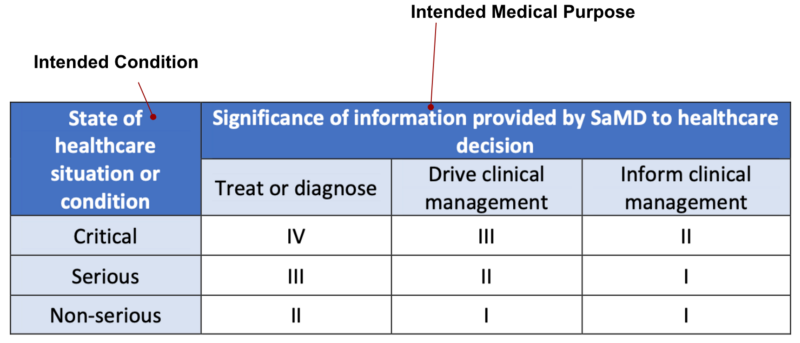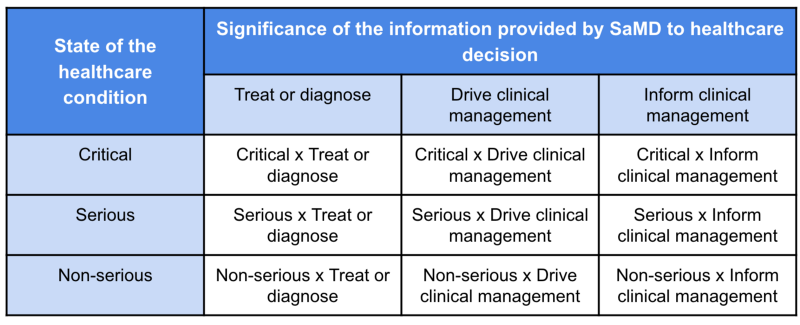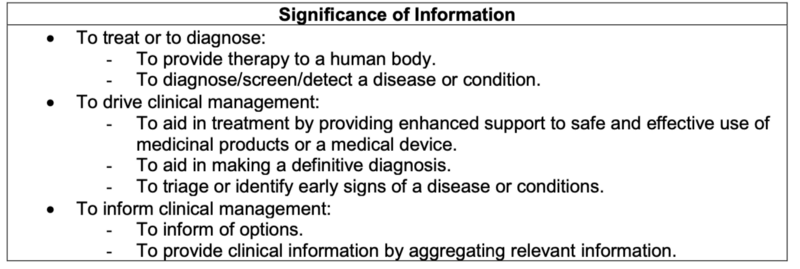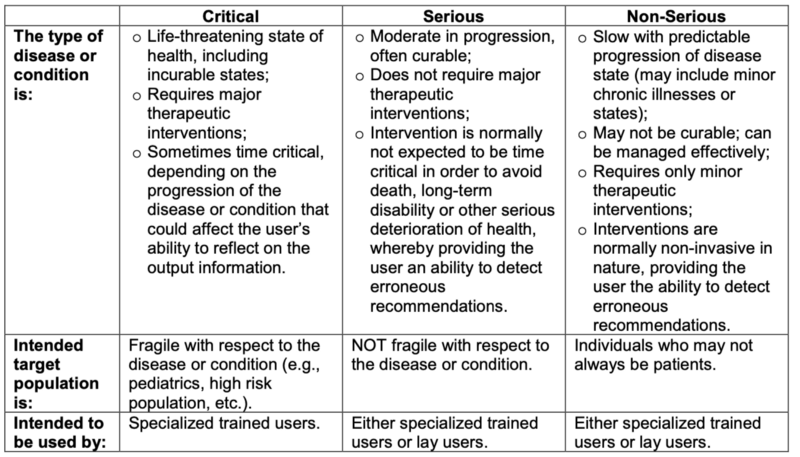【法規工具文】Quick-guide on Software Pre-Cert Program (3) — Review Pathway Determination
【導讀】本文最初用英文寫作,目的是保留FDA原意。而本版的目的為工具用文章,故用中文註釋以便快速抓到重點,但細節部分還是建議細讀英文說明
FDA審核醫療軟體是以風險為根據(Risk based approach). 而風險則是由該產品的預期用途(Intended Use)來判斷。
產品的預期用途(Intended Use)包含該醫療軟體所提供資訊對醫療決定的重要性(Significance of information provided by SaMD to healthcare decision, Table 3描述)以及醫療狀況或條件的狀態 (State of healthcare situation or condition, Table 4 描述)
這兩個部分決定了產品風險等級Table 1,及風險描述 Table 2. 最後佐以之前的組織卓越性等級,會在Table 5決定了審核路徑。
本章的重點在於Table1,2,5. 細節資訊則參考Table3, 4.
SaMD products included in the Pre-Cert Program will be reviewed via risk-based approach such as IMDRF framework. IMDRF framework is based on the description of intended use of SaMD, which consists of Significance of information provided by SaMD to healthcare decision and State of healthcare situation or condition. It is shown as Table 1.
Then, based on the pre-cert level determined from Excellence Appraisal, the review pathway will be determined via risk categorization according to the intended use.
It is also noted that review pathways determination, the 2nd component, is the product level process.

【導讀】風險分類就是根據該醫療軟體所提供資訊對醫療決定的重要性(Significance of information provided by SaMD to healthcare decision)以及醫療狀況或條件的狀態 (State of healthcare situation or condition)來決定。
Risk Categorization
The IMDRF framework establishes types of SaMD products based on the state of the healthcare condition and the significance of the information provided by the products shown as Table 1.

Risk description can also be arranged as Table 2 as a matrix of the state of the healthcare condition and the significance of the information.

Risk type and description will then be applied for review pathway determination.
【導讀】細部介紹醫療軟體所提供資訊對醫療決定的重要性(Significance of information provided by SaMD to healthcare decision)以及醫療狀況或條件的狀態 (State of healthcare situation or condition),以協助廠商決定風險等級。
The Significance of the information and the State of the healthcare condition
The “significance of the information provided by the SaMD to the healthcare decision,” which identifies the intended medical purpose of the SaMD, shown as Table 3 [1].

The “state of the healthcare situation or condition” that the SaMD is intended for, includes the intended user, intended disease or condition, and intended population, shown as Table 4 [2].

Description of the SaMD’s core functionality, which identifies the critical features/functions of the SaMD that are essential to the intended significance of the information provided by the SaMD to the healthcare decision in the intended healthcare situation or condition. This description should include only the critical features. This could include specific functionality to maintain performance, safety profile, and/or other attributes.
【導讀】重點為Table 5,綜合風險等級及組織level,決定了審核路徑。雖然本步驟是產品面的審核,但其路徑還是間接受到組織面的影響。
Review Pathway Determination
Table 5 below describes a potential future model for a premarket review pathway for SaMD from precertified companies, depending on (1) the IMDRF risk category of the SaMD and (2) the level of precertification of the organization.
SR represents Streamlined Review.

Though it is product level review process, the pathways are still indirectly affected by organization’s CQOE performance.
Notes:
[1] — The “significance of the information provided by the SaMD to the healthcare decision,” which identifies the intended medical purpose of the SaMD. The statement should explain how the SaMD meets the definition of a medical device in section 201(h) of the FD&C Act.13 The significance of the information provided by the SaMD and other information on the SaMD product need not be provided for functions that do not meet the definition of a device or that may meet the definition of a device but for which FDA does not intend to enforce compliance with applicable requirements of the FD&C Act. This statement could be structured in the following terms as defined in section 5.1 of the IMDRF N12 Framework document, which is Table 3 in this article.
[2] — The “state of the healthcare situation or condition” that the SaMD is intended for, includes the intended user, intended disease or condition, and intended population. The IMDRF risk framework allows for a systematic way to identify the context of the intended medical purpose of the SaMD. Information on the SaMD product need not be provided for functions that do not meet the definition of a device or that may meet the definition of a device but for which FDA does not intend to enforce compliance with applicable requirements of the FD&C Act.This statement would be structured in the following terms as defined in section 5.2 of the IMDRF N12 Framework document, which is Table 4 in this article.
